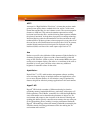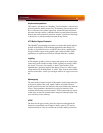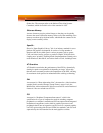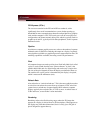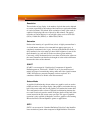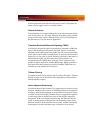
68
HDTV
Acronym for “High Definition Television,” a format that produces much
greater picture quality than a standard television, and in a wide-screen
format that matches that of a movie theater screen. The two most popular
formats are 1080i and 720p, where the number represents how many
horizontal scan lines they have, and the following letter represents whether
the picture is interlaced, or the product of progressive scanning technology.
Interlaced displays paint the odd-numbered scan lines and then the even-
numbered lines to produce a picture, whereas progressive scan paints all of
the scan lines at once. Both formats use an aspect ratio of 16:9. In contrast,
standard North American television signals are displayed using 480
interlaced (480i) scan lines with a more square aspect ratio of 4:3.
Hue
Refers to a specific color within the visible spectrum of light, defined by its
dominant wavelength. A light wave with a central tendency within the
range of 565-590 nm is visible as yellow. In the standard RGB color space
used by most computer displays, hue refers to a coordinate of the color as
described by its red, green, and blue values, minus any additional
brightness or saturation values for that color.
HydraVision
™
HydraVision
™
is ATI’s multi-monitor management software, enabling
users to manage the display of multiple windows and applications across
two or more adjacent monitors. It also includes a range of productivity
features designed to effectively manage applications in this environment.
HyperZ
™
HD
HyperZ
™
HD includes a number of different technologies aimed at
optimizing memory-bandwidth efficiency, particularly with respect to Z-
buffer operations. The Z-Buffer, sometimes also called the Depth Buffer,
stores information used to determine the placement of objects in a 3D
environment with respect to the viewpoint of the observer. Reading and
updating this buffer typically consumes more memory than any other part
of the 3D rendering process, making it a major performance bottleneck.
HyperZ
™
HD technology reduces the memory bandwidth consumed by the
Z-Buffer, thereby increasing performance while also making the 3D
environment more realistic.











